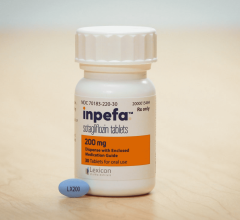April 6, 2012 — The U.S. anticoagulant market is on the verge of a major shift in clinical practice, transitioning from a market dominated by a single injectable anticoagulant to a highly competitive one dominated by first-in-class novel oral anticoagulants. Companies are vying with each other to introduce novel therapies that offer superior safety, efficacy and convenience to patients and physicians.
New analysis from Frost & Sullivan's Analysis of the Anticoagulant Market research finds that the market earned revenues of $4.7 billion in 2010 and expects it to reach $11.8 billion in 2016.
"Studies reveal that there are currently 2.7 million patients in the United States with atrial fibrillation (AF); however, this may be an underestimation as the actual figure could be as high as 4 million," said Frost & Sullivan senior industry analyst Deborah Toscano. "Lifelong anticoagulant therapy is critical for stroke prevention in these patients, resulting in substantial commercial opportunities."
Warfarin, the long-established gold standard therapy for stroke prevention in AF, carries many significant inherent risks such as bleeding, leaving a very narrow therapeutic window.
The market experienced a robust growth period following the launch of Pradaxa (dabigatran), an oral direct thrombin inhibitor (DTI), in late 2010, and Xarelto (rivaroxaban), an oral factor Xa inhibitor, in 2011. A second growth period is expected upon the anticipated launch of Eliquis (apixaban), an oral factor Xa inhibitor, in mid-2012. Edoxaban, an oral factor Xa inhibitor, is also in the pipeline. These agents are poised to dominate the market for stroke prevention in AF, a very large and partially untapped market. They are also likely to grab substantial market share from the parenteral anticoagulants for prophylaxis of venous thromboembolism in orthopedic joint replacement surgery.
With the approval of Pradaxa and Xarelto and the imminent approval of their successors, the bar has been significantly raised for the anticoagulant market. Superiority to warfarin is paramount for new drug approval and market uptake. Patient and clinician acceptance will depend on strong data showing improvements in efficacy and lower risk of bleeding.
There is a fine line between the prevention of thrombosis and uncontrollable bleeding. Most often, bleeding issues or other safety concerns may not arise until late-stage clinical trials, or only in certain patient populations, after significant investments in drug development have been made. In addition, bleeding issues or other safety concerns may surface in the future, particularly if the bleeding risk of the real-world population differs from that studied in clinical trials, leading to black-box warnings or market withdrawal. One of the shortcomings of oral anticoagulants is the lack of a strategy for reversal in case of emergency or uncontrolled bleeding.
"The oral anticoagulants are ideal for chronic therapy with their easy administration," said Toscano. "However, the ability to quickly reverse the anticoagulant action in the event of an emergency is a critical, unmet need."
Newcomers to the market that can address this issue will resolve the key shortfall of chronic anticoagulation therapy. Their drugs are likely to see rapid adoption into clinical practice.
For more information: www.pharma.frost.com


 July 10, 2024
July 10, 2024 








